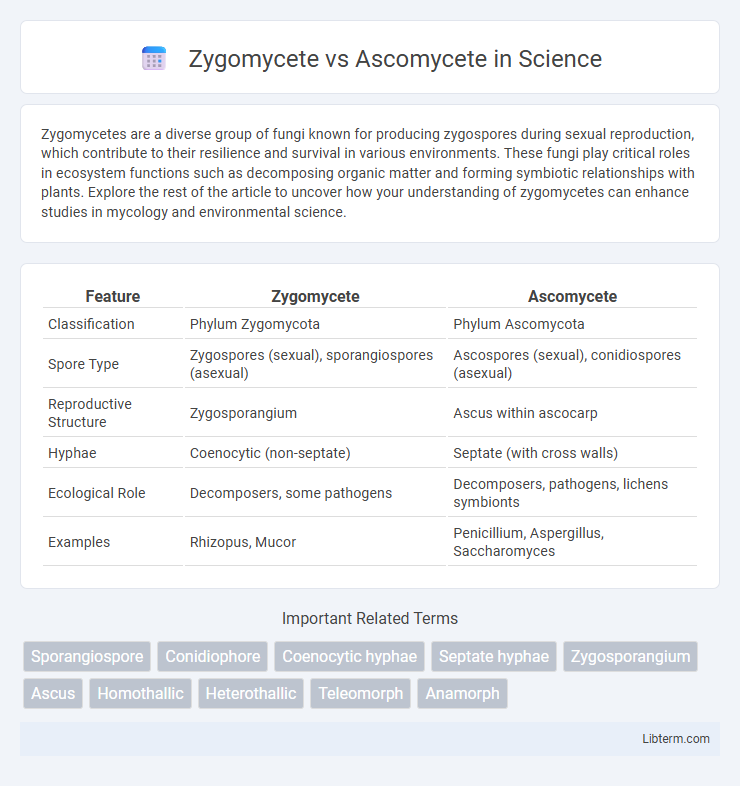Zygomycetes are a diverse group of fungi known for producing zygospores during sexual reproduction, which contribute to their resilience and survival in various environments. These fungi play critical roles in ecosystem functions such as decomposing organic matter and forming symbiotic relationships with plants. Explore the rest of the article to uncover how your understanding of zygomycetes can enhance studies in mycology and environmental science.
Table of Comparison
| Feature | Zygomycete | Ascomycete |
|---|---|---|
| Classification | Phylum Zygomycota | Phylum Ascomycota |
| Spore Type | Zygospores (sexual), sporangiospores (asexual) | Ascospores (sexual), conidiospores (asexual) |
| Reproductive Structure | Zygosporangium | Ascus within ascocarp |
| Hyphae | Coenocytic (non-septate) | Septate (with cross walls) |
| Ecological Role | Decomposers, some pathogens | Decomposers, pathogens, lichens symbionts |
| Examples | Rhizopus, Mucor | Penicillium, Aspergillus, Saccharomyces |
Introduction to Fungal Classification
Zygomycetes and Ascomycetes represent two major fungal groups differentiated by their reproductive structures, with Zygomycetes producing zygospores and Ascomycetes forming ascospores within asci. Zygomycetes are often fast-growing terrestrial fungi found in soil and decaying matter, playing critical roles in organic decomposition. Ascomycetes, the largest fungal phylum, includes species with diverse lifestyles such as pathogens, decomposers, and symbionts, recognized by their sac-like reproductive structures fundamental to fungal taxonomy.
Overview of Zygomycetes
Zygomycetes are a class of fungi characterized by the formation of zygospores during sexual reproduction, serving as a resistant structure for survival under adverse conditions. They primarily exhibit coenocytic hyphae, lacking septa, which distinguishes them from Ascomycetes that have septate hyphae and produce ascospores within asci. Zygomycetes play crucial ecological roles as decomposers, often found in soil and decaying organic matter, unlike Ascomycetes that encompass a broader range of lifestyles including pathogens and symbionts.
Overview of Ascomycetes
Ascomycetes, commonly known as sac fungi, represent the largest phylum within the kingdom Fungi, characterized by the production of spores in specialized sac-like structures called asci. Unlike Zygomycetes, which reproduce via zygospores, Ascomycetes undergo sexual reproduction through the formation of eight ascospores inside an ascus, contributing to their diverse ecological roles from decomposers to pathogens. This group includes economically important species used in biotechnology, such as Saccharomyces cerevisiae, critical for fermentation processes and antibiotic production.
Differences in Morphology
Zygomycetes exhibit coenocytic hyphae, lacking septa, which contrasts with the septate hyphae of Ascomycetes. Zygomycetes reproduce sexually through the formation of zygospores, whereas Ascomycetes produce sexual spores called ascospores within specialized sac-like structures called asci. The fruiting bodies in Ascomycetes, such as ascocarps, are often more complex and differentiated compared to the simpler sporangia found in Zygomycetes.
Reproductive Structures and Mechanisms
Zygomycetes reproduce sexually through the formation of zygosporangia, which are thick-walled, resistant structures that develop from the fusion of specialized hyphae called gametangia. In contrast, Ascomycetes produce sexual spores called ascospores within sac-like structures called asci, typically contained in fruiting bodies called ascocarps. Asexual reproduction in Zygomycetes involves sporangiospores produced in sporangia, whereas Ascomycetes generate asexual conidia on specialized hyphae called conidiophores.
Life Cycle Comparison
Zygomycetes exhibit a life cycle characterized by the formation of zygospores through the fusion of haploid gametangia during sexual reproduction, while their asexual phase produces sporangiospores in sporangia. Ascomycetes undergo a more complex life cycle involving the production of asci containing ascospores during sexual reproduction, with a prominent phase of asexual reproduction through conidia formation. The diploid phase in Ascomycetes is brief, with meiosis occurring immediately after karyogamy, contrasting with Zygomycetes where the diploid zygospore undergoes dormancy before meiosis.
Ecological Roles and Habitats
Zygomycetes primarily thrive in soil, decaying organic matter, and dung, playing a crucial role in decomposing complex carbohydrates and recycling nutrients in terrestrial ecosystems. Ascomycetes inhabit diverse environments including soil, freshwater, marine ecosystems, and living hosts, contributing significantly to nutrient cycling, symbiotic relationships such as lichens and mycorrhizae, and functioning as pathogens and decomposers. Both fungal groups are vital for ecosystem functioning but differ in their habitat specialization and ecological interactions, with Ascomycetes exhibiting broader ecological niches and more complex symbiotic roles.
Economic and Medical Importance
Zygomycetes play a crucial role in industrial applications such as fermentation and organic acid production, while some species like Rhizopus are used in food production and biotechnology. Ascomycetes include medically significant genera like Aspergillus and Penicillium, which are sources of antibiotics and immunosuppressants, along with pathogens causing diseases like aspergillosis. Economically, Ascomycetes dominate in pharmaceutical development and agriculture as both beneficial agents and plant pathogens, impacting crop yields and food security.
Genetic and Molecular Distinctions
Zygomycetes exhibit distinct genetic features such as a simpler genome organization with fewer genes involved in sexual reproduction compared to Ascomycetes, which possess a more complex and larger genome enriched with genes encoding for advanced secondary metabolites and intricate mating type loci. Molecularly, Ascomycetes utilize a well-characterized meiotic machinery with conserved genes like Spo11 and Dmc1 crucial for recombination, whereas Zygomycetes display unique regulatory pathways and proteins that govern zygospore formation, reflecting divergent evolutionary adaptations. The presence of specific gene clusters related to spore wall biosynthesis and signal transduction pathways further underscores the molecular divergence between these fungal lineages.
Summary: Key Differences Between Zygomycetes and Ascomycetes
Zygomycetes mostly reproduce sexually through the formation of zygospores, while Ascomycetes produce sexual spores called ascospores within specialized sac-like structures called asci. Zygomycetes typically have coenocytic hyphae lacking septa, in contrast to the septate hyphae of Ascomycetes. Ecologically, Zygomycetes are often found as fast-growing saprobes or parasites, whereas Ascomycetes include a diverse range of species from decomposers to important lichens and plant pathogens.
Zygomycete Infographic

 libterm.com
libterm.com